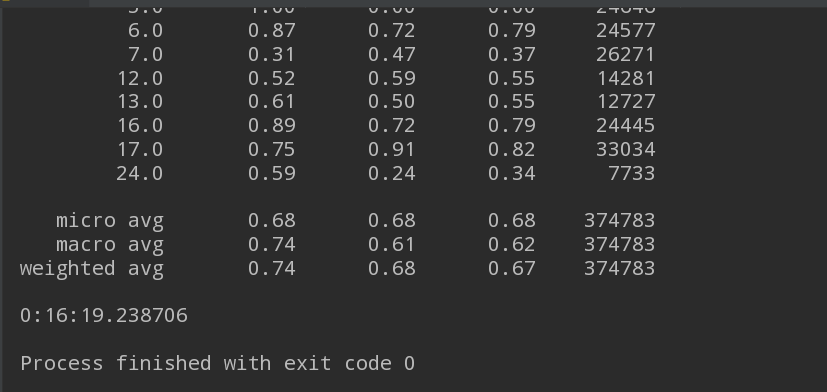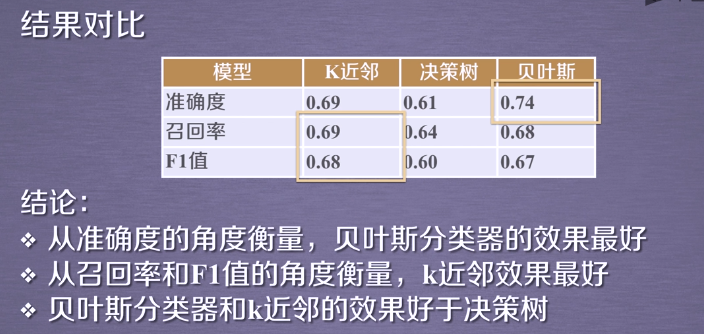2019-08-01【机器学习】有监督学习之分类 KNN,决策树,Nbayes算法实例 (人体运动状态信息评级)
样本:
使用的算法:
代码:
- import numpy as np
- import pandas as pd
- import datetime
- from sklearn.impute import SimpleImputer #预处理模块
- from sklearn.model_selection import train_test_split #训练集和测试集模块
- from sklearn.metrics import classification_report #预测结果评估模块
- from sklearn.neighbors import KNeighborsClassifier #K近邻分类器
- from sklearn.tree import DecisionTreeClassifier #决策树分类器
- from sklearn.naive_bayes import GaussianNB #高斯朴素贝叶斯函数
- starttime = datetime.datetime.now()
- def load_datasets(feature_paths, label_paths):
- feature = np.ndarray(shape=(0, 41)) #列数量和特征维度为41
- label = np.ndarray(shape=(0, 1))
- for file in feature_paths:
- #逗号分隔符读取特征数据,将问号替换标记为缺失值,文件不包含表头
- df = pd.read_table(file, delimiter=',', na_values='?', header=None)
- #df = df.fillna(df.mean()) #若SimpleImputer无法处理nan,则用pandas本身处理
- #使用平均值补全缺失值,然后将数据进行补全
- imp = SimpleImputer(missing_values=np.nan, strategy='mean') #此处与教程不同,版本更新,需要使用最新的函数填充NAn,暂不明如何调用
- imp.fit(df) #训练预处理器 此句有问题
- df = imp.transform(df) #生产预处理结果
- feature = np.concatenate((feature, df))#将新读入的数据合并到特征集中
- for file in label_paths:
- df = pd.read_table(file, header=None)
- #将新读入的数据合并到标签集合中
- label = np.concatenate((label, df))
- #将标签归整为一维向量
- label = np.ravel(label)
- return feature, label
- if __name__ == '__main__':
- #读取文件,根据本地目录文件夹而设定
- path = 'D:\python_source\Machine_study\mooc_data\classification\dataset/'
- featurePaths, labelPaths = [], []
- for i in range(0, 5, 1): #chr(ord('A') + i)==B/C/D
- featurePath = path + chr(ord('A') + i) + '/' + chr(ord('A') + i) + '.feature'
- featurePaths.append(featurePath)
- labelPath = path + chr(ord('A') + i) + '/' + chr(ord('A') + i) + '.label'
- labelPaths.append(labelPath)
- #将前4个数据作为训练集读入
- x_train, y_train = load_datasets(featurePaths[:4], labelPaths[:4])
- #将最后一个数据作为测试集读入
- x_test, y_test = load_datasets(featurePaths[4:], labelPaths[4:])
- #使用全量数据作为训练集,借助函数将训练数据打乱,便于后续分类器的初始化和训练
- x_train, x_, y_train, y_ = train_test_split(x_train, y_train, test_size=0.0)
- print('Start training knn')
- knn = KNeighborsClassifier().fit(x_train, y_train) #使用KNN算法进行训练
- print('Training done')
- answer_knn = knn.predict(x_test)
- print('Start training DT')
- dt = DecisionTreeClassifier().fit(x_train, y_train) #使用决策树算法进行训练
- print('Training done')
- answer_dt = dt.predict(x_test)
- print('Prediction done')
- print('Start training Bayes')
- gnb = GaussianNB().fit(x_train, y_train) #使用贝叶斯算法进行训练
- print('Training done')
- answer_gnb = gnb.predict(x_test)
- print('Prediction done')
- #对分类结果从 精确率precision 召回率recall f1值fl-score和支持度support四个维度进行衡量
- print('\n\nThe classification report for knn:')
- print(classification_report(y_test, answer_knn))
- print('\n\nThe classification report for DT:')
- print(classification_report(y_test, answer_dt))
- print('\n\nThe classification report for Bayes:')
- print(classification_report(y_test, answer_gnb))
- endtime = datetime.datetime.now()
- print(endtime - starttime) #时间统计
效果图:


2019-08-01【机器学习】有监督学习之分类 KNN,决策树,Nbayes算法实例 (人体运动状态信息评级)的更多相关文章
- 吴裕雄 python 机器学习——半监督学习标准迭代式标记传播算法LabelPropagation模型
import numpy as np import matplotlib.pyplot as plt from sklearn import metrics from sklearn import d ...
- 【纪中集训】2019.08.01【NOIP提高组】模拟 A 组TJ
T1 Description 给定一个\(N*N(N≤8)\)的矩阵,每一格有一个0~5的颜色.每次可将左上角的格子所在连通块变为一种颜色,求最少操作数. Solution IDA*=启发式迭代加深 ...
- 机器学习--最邻近规则分类KNN算法
理论学习: 3. 算法详述 3.1 步骤: 为了判断未知实例的类别,以所有已知类别的实例作为参照 选择参数K 计算未知实例与所有已知实例的距离 选 ...
- 机器学习——十大数据挖掘之一的决策树CART算法
本文始发于个人公众号:TechFlow,原创不易,求个关注 今天是机器学习专题的第23篇文章,我们今天分享的内容是十大数据挖掘算法之一的CART算法. CART算法全称是Classification ...
- 【Todo】【转载】Spark学习 & 机器学习(实战部分)-监督学习、分类与回归
理论原理部分可以看这一篇:http://www.cnblogs.com/charlesblc/p/6109551.html 这里是实战部分.参考了 http://www.cnblogs.com/shi ...
- Python 机器学习实战 —— 监督学习(下)
前言 近年来AI人工智能成为社会发展趋势,在IT行业引起一波热潮,有关机器学习.深度学习.神经网络等文章多不胜数.从智能家居.自动驾驶.无人机.智能机器人到人造卫星.安防军备,无论是国家级军事设备还是 ...
- Python 机器学习实战 —— 监督学习(上)
前言 近年来AI人工智能成为社会发展趋势,在IT行业引起一波热潮,有关机器学习.深度学习.神经网络等文章多不胜数.从智能家居.自动驾驶.无人机.智能机器人到人造卫星.安防军备,无论是国家级军事设备还是 ...
- python_机器学习_监督学习模型_决策树
决策树模型练习:https://www.kaggle.com/c/GiveMeSomeCredit/overview 1. 监督学习--分类 机器学习肿分类和预测算法的评估: a. 准确率 b.速度 ...
- 机器学习实战 - 读书笔记(07) - 利用AdaBoost元算法提高分类性能
前言 最近在看Peter Harrington写的"机器学习实战",这是我的学习笔记,这次是第7章 - 利用AdaBoost元算法提高分类性能. 核心思想 在使用某个特定的算法是, ...
随机推荐
- kerberos系列之hive认证配置
大数据安全系列之hive的kerberos认证配置,其它系列链接如下 https://www.cnblogs.com/bainianminguo/p/12548076.html-----------安 ...
- Redis缓存设计与性能优化
Redis我们一般是用作缓存,扛并发:或者用于某些特定的业务场景,比如前面说到redis各种数据类型的使用场景以及redis的哨兵和集群模式. 这里主要整理了下redis用作缓存,存在的一些问题,以及 ...
- 【codeforces】Codeforces Round #612 (Div. 2) C. Garland——DP
题目链接 贪心模拟了半天,最后放弃了 题意 给你一串从1−n1-n1−n的序列,其中部分未知(表示为0),补全序列使得相邻数值奇偶性相反的数量最少 相邻数值的奇偶性相反:两个相邻的两个数值,其中一个为 ...
- Data Management and Data Management Tools
Data Management ObjectivesBy the end o this module, you should understand the fundamentals of data m ...
- Building Applications with Force.com and VisualForce (DEV401) (二) : Application Essentials:Designing Application on the Force.com Platform
Dev 401-002:Application Essentials:Designing Application on the Force.com Platform Course Objectives ...
- TensorFlow v2.0实现逻辑斯谛回归
使用TensorFlow v2.0实现逻辑斯谛回归 此示例使用简单方法来更好地理解训练过程背后的所有机制 MNIST数据集概览 此示例使用MNIST手写数字.该数据集包含60,000个用于训练的样本和 ...
- 万字综述,核心开发者全面解读PyTorch内部机制
斯坦福大学博士生与 Facebook 人工智能研究所研究工程师 Edward Z. Yang 是 PyTorch 开源项目的核心开发者之一.他在 5 月 14 日的 PyTorch 纽约聚会上做了一个 ...
- [算法]合并链表&删除数组重复项
合并链表 题目 将两个有序链表合并为一个新的有序链表并返回.新链表是通过拼接给定的两个链表的所有节点组成的. 示例: 输入:1->2->4, 1->3->4 输出:1-> ...
- [tyvj2032]升降梯上<dp&spfa>
题目背景 开启了升降梯的动力之后,探险队员们进入了升降梯运行的那条竖直的隧道,映入眼帘的是一条直通塔顶的轨道.一辆停在轨道底部的电梯.和电梯内一杆控制电梯升降的巨大手柄. 题目描述 Nescafe 之 ...
- 常见SQL语句和SQL基础知识
引自:http://blog.csdn.net/u012467492/article/details/46790205 SQL语句考察(一) 1.查询出每门课都大于80 分的学生姓名 name k ...
